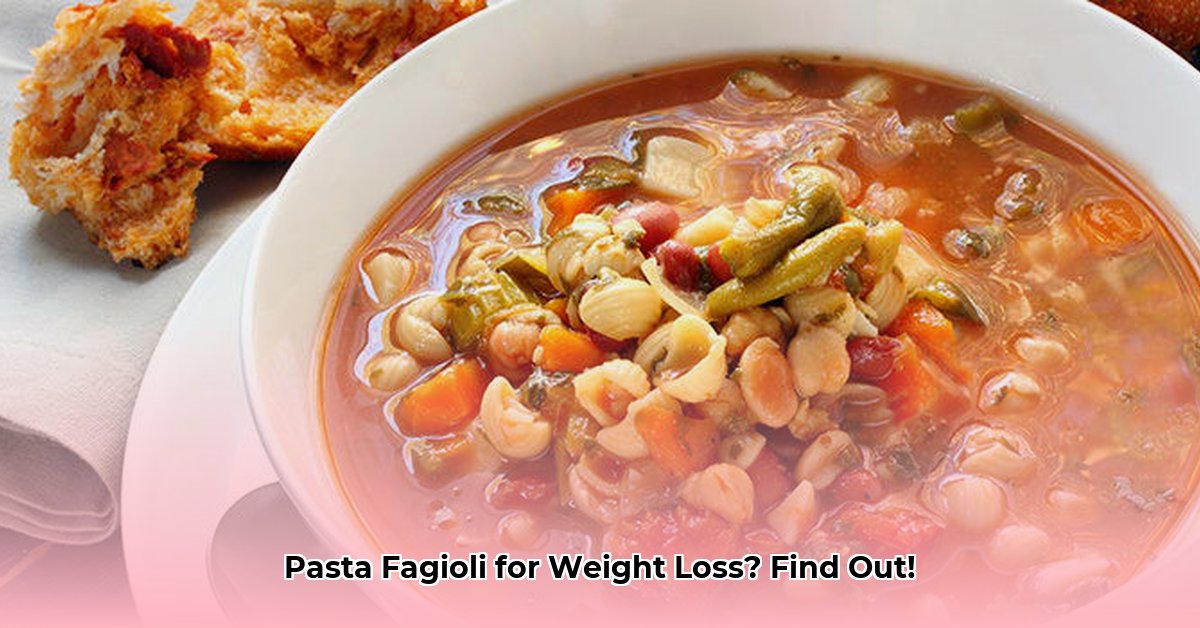
Pasta fagioli, a hearty Italian soup brimming with pasta, beans, and vegetables, offers a comforting culinary experience. But can it truly contribute to your weight loss journey? This comprehensive guide delves into the nutritional aspects of pasta fagioli, providing actionable strategies and delicious recipes to help you incorporate it into a weight-managing diet.
Understanding Pasta Fagioli and Weight Loss
The relationship between pasta fagioli and weight loss isn't simply a yes or no answer. It's a nuanced equation influenced by several key factors. On the positive side, pasta fagioli provides protein and fiber, both essential for weight management. Protein promotes satiety (feeling full), curbing cravings, while fiber aids digestion and regulates blood sugar levels, preventing energy crashes that often lead to overeating.
However, traditional recipes often contain significant amounts of sodium. Excess sodium leads to water retention, causing bloating that can mask actual weight loss and potentially increase blood pressure. Moreover, while a single serving isn't excessively high in calories, portion control is paramount. Even healthy foods can contribute to weight gain if consumed in excessive quantities.
Smart Swaps for a Slimmer Soup
The beauty of pasta fagioli lies in its adaptability. By making simple substitutions and adjustments, you can transform this comforting classic into a powerful ally in your weight loss efforts.
Whole Wheat Upgrade: Replace refined pasta with whole wheat pasta. The added fiber significantly increases satiety, keeping you fuller for longer and reducing the likelihood of overeating later.
Veggie Boost: Amplify the vegetable content! Incorporate spinach, carrots, zucchini, or your favorite vegetables. More vegetables mean increased nutrient density and a lower overall calorie count per serving.
Low-Sodium Strategy: Utilize low-sodium or no-salt-added broth. This single change dramatically reduces the sodium content. Even better, consider making your own broth from scratch for complete control over ingredients and flavor.
Spice Enhancement: Instead of relying on salt for flavor, experiment with a variety of herbs and spices. Garlic, oregano, basil, and rosemary offer intense flavor profiles without the added sodium.
Your 7-Day Pasta Fagioli Plan: A Sample Guide
This sample plan provides a framework for incorporating pasta fagioli into your weekly diet. Remember, individual calorie needs vary, so adjust portion sizes according to your specific requirements and consult a registered dietitian or nutritionist for personalized guidance.
| Day | Serving Size (cups) | Additional Tips |
|---|---|---|
| 1 | 1.5 | Pair with a side salad for added nutrients and volume. |
| 2 | 1 | Enjoy with a small slice of whole-wheat bread. |
| 3 | 1.5 | Include a lean protein source like grilled chicken. |
| 4 | 1 | Integrate into a balanced, larger meal. |
| 5 | 1.5 | Add a side of steamed broccoli or other green vegetables. |
| 6 | 1 | Enjoy as a light lunch paired with a piece of fruit. |
| 7 | 1 | Take a break from the soup; focus on other healthy meals. |
How to Reduce Sodium in Pasta Fagioli for Weight Loss
The primary challenge with pasta fagioli and weight loss is often its sodium content. However, through strategic modifications, you can easily mitigate this concern.
Understanding the Sodium Challenge
While pasta fagioli offers numerous nutritional benefits, many traditional recipes are high in sodium. High sodium intake leads to water retention, bloating, and potentially elevated blood pressure, all of which can hinder weight loss progress and overall health.
Strategies for Lower-Sodium Pasta Fagioli
Here’s how to create a lower-sodium version of this beloved soup:
Broth Selection: Choose low-sodium or no-salt-added broth. Homemade broth provides ultimate control over ingredients and sodium levels.
Spice Infusion: Unlock the power of herbs and spices! Garlic, oregano, basil, and other aromatic herbs add depth of flavor without increasing sodium.
Bean Rinse: If using canned beans, thoroughly rinse them under cold water to remove excess sodium.
Salt Substitute (Use Cautiously): Potassium chloride is a common salt substitute, but use it sparingly. Excessive potassium intake can be detrimental to some individuals; consult your doctor before using salt substitutes.
Gradual Adjustment: Gradually reduce salt intake to allow your palate to adjust to the new flavor profile.
Sample Low-Sodium Pasta Fagioli Recipe (Serves 4)
- 1 tbsp olive oil
- 1 onion, chopped
- 2 carrots, chopped
- 2 celery stalks, chopped
- 1 cup ditalini pasta (whole wheat preferred)
- 1 (28 ounce) can crushed tomatoes (low sodium)
- 4 cups low-sodium vegetable broth
- 1 (15 ounce) can cannellini beans, rinsed
- 1 tsp dried oregano
- 1/2 tsp dried basil
- 1/4 tsp black pepper
- Fresh parsley, for garnish
Instructions:
- Sauté onions, carrots, and celery in olive oil until softened.
- Add pasta, tomatoes, broth, beans, oregano, basil, and pepper.
- Bring to a boil, reduce heat, and simmer for 20 minutes, or until pasta is cooked through.
- Garnish with fresh parsley.
Portion Control: The Key to Success
Even with a low-sodium pasta fagioli recipe, portion control remains crucial. Weight loss is fundamentally about balancing calorie intake and expenditure. Mindful portioning ensures that even healthy foods contribute to, not hinder, your weight loss goals. Remember to listen to your body's hunger and fullness cues.
The Bottom Line: Your Weight Loss Journey
Pasta fagioli can undoubtedly be a part of a healthy weight loss plan. Strategic substitutions, portion control, and mindful eating habits are key to maximizing its benefits. By making informed choices, you can enjoy this comforting soup while progressing toward your weight loss goals. Remember to consult with a healthcare professional or registered dietitian for personalized dietary advice.